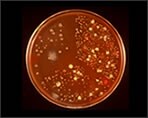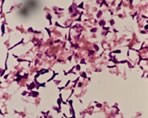Tomotari Mitsuoka:Early days of research(1)
Looking back in time … Research work encompassing over a half century
Started research on intestinal bacteria at graduate school.
In 1950, I enrolled at the Department of Veterinary Medicine at the University of Tokyo for my undergraduate study, where I majored in veterinary medicine which covered almost all aspects of basic medicine. Then I went on to attend graduate school at the same university, and joined a livestock bacteriology laboratory.
The research topic I was assigned by my supervisor, Dr. Yuichi Ochi, was to study the intestinal microbiota (gut flora) of chickens. It was the start of my extensive research on intestinal bacteria.
Although no systematic research on intestinal bacteria existed in Japan at the time, I somehow managed to review and organize all scholarly literature that was available in Japan and the rest of the world (one hundred and several tens of academic papers) in five months, and presented my findings at a seminar conference of the laboratory. This research was later published in an academic journal, in the form of a review article on the research topic in three volumes.
Discovered bifidobacteria in stool.
Then, I finally reached the crux of my budding career, when I started examining ways to effectively culture intestinal flora. At this point, I was frustrated by the fact that, although 10 billion bacteria were known to exist in every gram of stool, the technology available at the time only allowed us to culture 100 million of them.
So I first adopted the method that was commonly used back then, called the Hosoya method of anaerobic culturing, and came up with the idea of using glucose/blood/liver (BL) agar plates as culture medium. By using these for the experiment, I was able to culture the bacteria 10 to 100 times more effectively than the conventional method, and most of those bacteria turned out to be lactobacilli and other anaerobic bacteria, which could not be cultured before. This is how the BL medium was developed, which is used to culture lactobacilli and bifidobacteria today.
When I used this BL medium and cultured my own stool on it, I discovered that the dominant type of bifidobacteria was different from the bifidobacteria found in infants. Although it was considered at the time that adults had no bifidobacteria inside their bodies, I became convinced that those bifidobacteria I found in adults were the component of intestinal microbiota that was crucial for host health. This intuition led to intensive research on human gut flora that would start 10 years later.
 |
 |
Culturing adult stool on BL agar plates |
Cultured population of bifidobacteria |
The deep disciplines of bacterial taxonomy and microbial biology
In 1958 I was hired by the renowned Institute of Physical and Chemical Research (RIKEN) to work as a scientist. When I joined RIKEN, there was no facility where I could raise chickens for experiments, so I decided to raise them at my own home instead, in an annex. I proceeded to study the intestinal flora of chickens with this set-up, and discovered that the flora of chicks became fully mature and complete upon reaching the age of 28 days, which was the opposite finding of previously published studies. I called this discovered phenomenon “the principle of change in intestinal flora,” and published it in a German bacteriology journal. The study caused quite a commotion among scientists, and led to the subsequent discovery of the biological principle of age-induced change in human intestinal flora, which would form a key basis on which various functional foods are developed today.